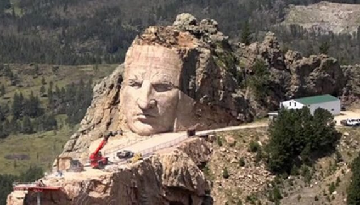November is National American Indian Heritage month, which celebrates the native culture, and honors native history. Currently, there are 574 federally recognized tribes in the United States, in addition to tribes only recognized at the state level, and those petitioning for recognition.
For this article, we will focus on an unparalleled educational and humanitarian project: The Crazy Horse Memorial Foundation. Per the official website, the mission of the Foundation is to “protect and preserve the culture, tradition, and living heritage of the North American Indians.” This foundation also endeavors to act as repository for Native American artifacts through the Indian Museum of North America and the Native American Educational and Cultural Center, and has established the Indian University of North America.
The Foundation also continues the progress of The Crazy Horse Memorial, recognized as the world’s largest mountain carving, which is located in the Black Hills of South Dakota. Chief Henry Standing Bear commissioned the construction of this monument in 1948, by sculptor Korczak Ziolkowski, who also sculpted Mount Rushmore. The construction of The Crazy Horse Memorial continues to this day, and at completion is slated to stand 563 feet high and 641 feet long. Crazy Horse’s face was completed in the late 1990s; crews are now working on shaping the horse’s head and Crazy Horse’s outstretched arm.
Crazy Horse (1842-1877) was a warrior from the Lakota Sioux tribe. The Sioux tribe was indigenous to the area between the Rocky Mountains and the Great Lakes. Crazy Horse earned great respect from his tribe, as well as his enemies in battles fought to preserve the traditional way of life of the Sioux people. As quoted in Literature of the American Indian (1973) by Thomas Edward Sanders and Walter W. Peek, p. 294:
My friend, I do not blame you for this. Had I listened to you this trouble would not have happened to me. I was not hostile to the white men. Sometimes my young men would attack the Indians who were their enemies and took their ponies. They did it in return. We had buffalo for food, and their hides for clothing and for our tepees. We preferred hunting to a life of idleness on the reservation, where we were driven against our will. At times we did not get enough to eat and we were not allowed to leave the reservation to hunt. We preferred our own way of living. We were no expense to the government. All we wanted was peace and to be left alone. Soldiers were sent out in the winter, they destroyed our villages. The "Long Hair" [Custer] came in the same way. They say we massacred him, but he would have done the same thing to us had we not defended ourselves and fought to the last. Our first impulse was to escape with our squaws and papooses, but we were so hemmed in that we had to fight. After that I went up on the Tongue River with a few of my people and lived in peace. But the government would not let me alone. Finally, I came back to the Red Cloud Agency. Yet, I was not allowed to remain quiet. I was tired of fighting. I went to the Spotted Tail Agency and asked that chief and his agent to let me live there in peace. I came here with the agent [Lee] to talk with the Big White Chief but was not given a chance. They tried to confine me. I tried to escape, and a soldier ran his bayonet into me. I have spoken.
Diversity, Equity and Inclusiveness holidays are meant to bring visibility to traditionally marginalized communities and identities. However, we should strive to commemorate, recognize, and celebrate our differences, traditions, and heritages year-round. There are charities to support Native American Preservation.
Please click here for a list of the (574) Federally Recognized Tribes from the National Conference of State Legislatures. A list of State Recognized Tribes is attached.
Lauren Krofcheck is a partner in the firm’s Pittsburgh office and a member of the Diversity, Equity and Inclusion Committee.

